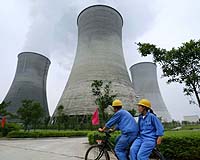 |
Corvallis OR (SPX) Jan 04, 2011 Members of the engineering faculty at Oregon State University have invented a new type of radiation detection and measurement device that will be particularly useful for cleanup of sites with radioactive contamination, making the process faster, more accurate and less expensive. A patent has been granted on this new type of radiation spectrometer, and the first production of devices will begin soon. The advance has also led to creation of a Corvallis-based spinoff company, Avicenna Instruments, based on the OSU research. The market for these instruments may ultimately be global, and thousands of them could be built, researchers say. Hundreds of millions of dollars are spent on cleanup of some major sites contaminated by radioactivity, primarily from the historic production of nuclear weapons during and after World War II. These include the Hanford site in Washington, Savannah River site in South Carolina, and Oak Ridge National Laboratory in Tennessee. "Unlike other detectors, this spectrometer is more efficient, and able to measure and quantify both gamma and beta radiation at the same time," said David Hamby, an OSU professor of health physics. "Before this two different types of detectors and other chemical tests were needed in a time-consuming process." "This system will be able to provide accurate results in 15 minutes that previously might have taken half a day," Hamby said. "That saves steps, time and money." The spectrometer, developed over 10 years by Hamby and Abi Farsoni, an assistant professor in the College of Engineering, can quickly tell the type and amount of radionuclides that are present in something like a soil sample - contaminants such as cesium 137 or strontium 90 - that were produced from reactor operations. And it can distinguish between gamma rays and beta particles, which is necessary to determine the level of contamination. "Cleaning up radioactive contamination is something we can do, but the process is costly, and often the question when working in the field is how clean is clean enough," Hamby said. "At some point the remaining level of radioactivity is not a concern. So we need the ability to do frequent and accurate testing to protect the environment while also controlling costs." This system should allow that, Hamby said, and may eventually be used in monitoring processes in the nuclear energy industry, or possibly medical applications in the use of radioactive tracers. The OSU College of Engineering has contracted with Ludlum Instruments, a Sweetwater, Texas, manufacturer, to produce the first instruments, and the OSU Office of Technology Transfer is seeking a licensee for commercial development. The electronic systems for the spectrometers will be produced in Oregon by Avicenna Instruments, the researchers said.
Share This Article With Planet Earth
Related Links - Nuclear Power News - Nuclear Science, Nuclear Technology Powering The World in the 21st Century at Energy-Daily.com
 China announces nuclear fuel breakthrough
China announces nuclear fuel breakthroughBeijing (AFP) Jan 3, 2011 Chinese scientists have made a breakthrough in nuclear fuel reprocessing technology that could effectively end any uranium supply concerns, state media reported on Monday. The technology developed by state-run China National Nuclear Corp enables the country to re-use irradiated nuclear fuel, China Central Television said. "China's proven uranium sources will last only 50 to 70 years, but ... read more |
|
| The content herein, unless otherwise known to be public domain, are Copyright 1995-2010 - SpaceDaily. AFP and UPI Wire Stories are copyright Agence France-Presse and United Press International. ESA Portal Reports are copyright European Space Agency. All NASA sourced material is public domain. Additional copyrights may apply in whole or part to other bona fide parties. Advertising does not imply endorsement,agreement or approval of any opinions, statements or information provided by SpaceDaily on any Web page published or hosted by SpaceDaily. Privacy Statement |